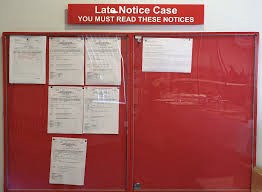Since late notice cases were first introduced back in 1947 following a serious accident at Goswick on the East Coast main line, they have become a permanent fixture of every railway messroom.
Those familiar red, glass-framed noticeboards are the standard way to notify train crews of any short notice changes to their routes, such as emergency speed restrictions (ESRs) or diversions, when they sign on for duty.
It’s a system that’s worked for more than 70 years. But now we operate in a faster, busier and more complex rail network, is it time to say goodbye to the old cork noticeboard and drawing pins?
Pitfalls of paper and pinboards
As with any paper-based system, there are drawbacks to the traditional late notice case.
When you’re relying on someone to create a notice on a piece of card, take it over to the messroom and pin it onto the wall, there’s obviously room for error to creep in. The messenger might be delayed on their mission, or they might fix the card to the noticeboard only for it to slip behind the other notices or fall off altogether.
The other problem is how to be sure the relevant drivers and crew have read the notice.
While most operators have a system which prioritises late notices and makes the most recent updates stand out, you can never be completely sure the message has reached its intended target.
Risks and repercussions of missed notices
This uncertainty is a worry, because all late notices are, by their very nature, important. These notices provide the essential safety check to ensure a driver is aware of a blanket speed restriction in place due to hot weather, or that there’s an ESR on the line following an earlier incident.
When a driver misses a late notice, the risks are all too evident.
Reports from the Rail Accident Investigation Branch (RAIB) reveal episodes of over-speeding, near misses and other safety issues. In the most extreme cases, trains have travelled at more than 70mph over the recommended speed because drivers and crew were unaware of a current speed restriction.
While the impact of missed notices can be minor, at worst, the outcome could be catastrophic.
So how could moving to a digital noticeboard help to improve safety on the railway?
Notices straight from control room to crew
A digital solution could herald the end to loose drawing pins, missing notices and unread updates, and this would help to reduce safety incidents on the network.
Rather than carrying paper from one office to another, controllers could send messages directly from a single, central system and display them on a big screen in the messroom – the digital version of the late notice case.
The screen would contain up to 12 notices in time and date order, with the most recent notice in pole position on the top left-hand side, and in keeping with the look of the traditional late notice case, the most recent notices would have a clear read border.
Each time the control room adds updated information about a speed restriction or diversion, the notices move along the screen.
Another bugbear of the old cork noticeboards is when they become clogged up with old, irrelevant notices, running the risk of drivers not seeing the information that matters. A digital noticeboard gives you the option to add ‘valid from’ and ‘valid to’ dates, so as soon as the update is out-of-date it disappears.
Instead of important notices being lost or crowded out, they are read and understood.
The past 70 years have seen big changes in the world of rail, with passengers and freight customers relying on faster trains to help them thrive in a busier, more competitive world. It’s time for technology to bring the late notice case into the 21st century too, for a safer, more connected railway.
Register here to stay in touch with all our developments in the area of safety critical communications, including our new digital noticeboard.
